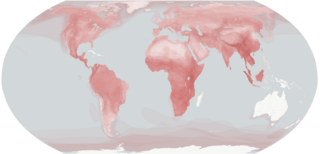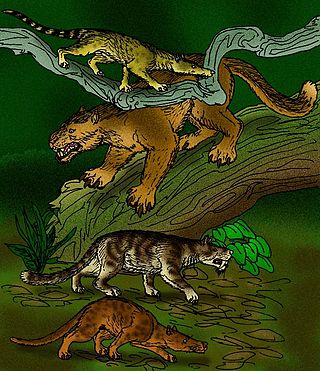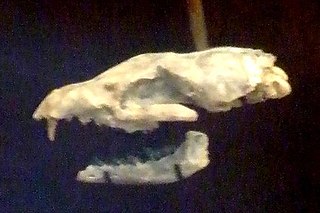
Bears are carnivoran mammals of the family Ursidae. They are classified as caniforms, or doglike carnivorans. Although only eight species of bears are extant, they are widespread, appearing in a wide variety of habitats throughout most of the Northern Hemisphere and partially in the Southern Hemisphere. Bears are found on the continents of North America, South America, and Eurasia. Common characteristics of modern bears include large bodies with stocky legs, long snouts, small rounded ears, shaggy hair, plantigrade paws with five nonretractile claws, and short tails.

Carnivora is an order of placental mammals that have specialized in primarily eating flesh, whose members are formally referred to as carnivorans. The order Carnivora is the fifth largest order of mammals, comprising at least 279 species.

Ungulates are members of the diverse clade Euungulata which primarily consists of large mammals with hooves. Once part of the clade "Ungulata" along with the clade Paenungulata, "Ungulata" has since been determined to be a polyphyletic and thereby invalid clade based on molecular data. As a result, true ungulates had since been reclassified to the newer clade Euungulata in 2001 within the clade Laurasiatheria while Paenungulata has been reclassified to a distant clade Afrotheria. Living ungulates are divided into two orders: Perissodactyla including equines, rhinoceroses, and tapirs; and Artiodactyla including cattle, antelope, pigs, giraffes, camels, sheep, deer, and hippopotamuses, among others. Cetaceans such as whales, dolphins, and porpoises are also classified as artiodactyls, although they do not have hooves. Most terrestrial ungulates use the hoofed tips of their toes to support their body weight while standing or moving. Two other orders of ungulates, Notoungulata and Litopterna, both native to South America, became extinct at the end of the Pleistocene, around 12,000 years ago.

Ursinae is a subfamily of Ursidae (bears) named by Swainson (1835). It was assigned to Ursidae by Bjork (1970), Hunt (1998), and Jin et al. (2007).

Amphicyonidae is an extinct family of terrestrial carnivorans belonging to the suborder Caniformia. They first appeared in North America in the middle Eocene, spread to Europe by the late Eocene, and further spread to Asia and Africa by the early Miocene. They had largely disappeared worldwide by the late Miocene, with the latest recorded species at the end of the Miocene in Africa. They were among the first carnivorans to evolve large body size. Amphicyonids are colloquially referred to as "bear-dogs".

Caniformia is a suborder within the order Carnivora consisting of "dog-like" carnivorans. They include dogs, bears, raccoons, and mustelids. The Pinnipedia are also assigned to this group. The center of diversification for the Caniformia is North America and northern Eurasia. Caniformia stands in contrast to the other suborder of Carnivora, the Feliformia, the center of diversification of which was in Africa and southern Asia.

Ailuridae is a family in the mammal order Carnivora. The family consists of the red panda and its extinct relatives.

Creodonta is a former order of extinct carnivorous placental mammals that lived from the early Paleocene to the late Miocene epochs in North America, Europe, Asia and Africa. Originally thought to be a single group of animals ancestral to the modern Carnivora, this order is now usually considered a polyphyletic assemblage of two different groups, the Oxyaenids and the Hyenodonts, not a natural group. Oxyaenids are first known from the Palaeocene of North America, while hyaenodonts hail from the Palaeocene of Africa.

Ailuropodinae is a subfamily of Ursidae that contains only one extant species, the giant panda of China. The fossil record of this group has shown that various species of pandas were more widespread across the Holarctic, with species found in places such as Europe, much of Asia and even North America. The earliest pandas were not unlike other modern bear species in that they had an omnivorous diet but by around 2.4 million years ago, pandas have evolved to be more herbivorous.

The Tremarctinae or short-faced bears is a subfamily of Ursidae that contains one living representative, the spectacled bear of South America, and several extinct species from four genera: the Florida spectacled bear, the North American giant short-faced bears Arctodus, the South American giant short-faced bear Arctotherium as well as Plionarctos(P. edensis and P. harroldorum), which is thought to be ancestral to the other three genera. Of these, the giant short-faced bears may have been the largest ever carnivorans in the Americas. The group is thought to have originated in eastern North America, and then invaded South America as part of the Great American Interchange. Most short-faced bears became extinct at the end of the Pleistocene.

Simocyon is a genus of extinct carnivoran mammal in the family Ailuridae. Simocyon, which was about the size of a mountain lion, lived in the late Miocene and early Pliocene epochs, and has been found in Europe, Asia, and rarely, North America and Africa.
Parictis is an extinct arctoid belonging to the family Subparictidae.

Kolponomos is an extinct genus of carnivoran mammal that existed in the Late Arikareean North American Land Mammal Age, early Miocene epoch, about 20 million years ago. It was likely a marine mammal. The genus was erected in 1960 by Ruben A. Stirton, a paleontologist at the University of California Museum of Paleontology, Berkeley, for the species K. clallamensis, on the basis of a partial skull and jaw found on the Olympic Peninsula. At the time, Stirton questionably assigned it to Procyonidae, its systematic position remained problematic until the discovery of more fossils including a nearly complete cranium from the original locality of K. clallamensis which helped identify it as part of the group from which pinnipeds evolved.

Cormocyon is an extinct genus of borophagine canid native to North America. It lived from the Oligocene to the Early Miocene, 30.8—20.6 Mya, existing for about 10.2 million years. It is regarded as a primitive, transitional member of the Borophagini tribe.

Hemicyoninae is an extinct subfamily of Ursidae, often called dog bears. They were bear-like carnivorans living in Europe, North America, Africa and Asia during the Oligocene through Miocene epochs 33.9–5.3 Ma, existing for approximately 28.6 million years. They are sometimes classified as a separate family.

Ursavini is an extinct tribe of mammals of the family Ursidae (bears) endemic to North America, Europe, Africa, and Asia during the Miocene through the Pliocene, living from about 23—2.5 Mya, existing for roughly 20.5 million years.

Arctotherium is an extinct genus of the Pleistocene short-faced bears endemic to Central and South America. Arctotherium migrated from North America to South America during the Great American Interchange, following the formation of the Isthmus of Panama during the late Pliocene. The genus consists of one early giant form, A. angustidens, and several succeeding smaller species, which were within the size range of modern bears. Arctotherium was adapted to open and mixed habitat. They are genetically closer to the spectacled bear, than to Arctodus of North America, implying the two extinct forms evolved large size in a convergent manner.

Kretzoiarctos is an extinct bear genus from the European Miocene. It consists of Kretzoiarctos beatrix, an ancestor of the extant giant panda.
Huracan is an extinct genus of agriotheriin ailuropodine from the Neogene period. Fossils were found from North America and Eastern Asia. Unlike its modern relative the giant panda, which is a bamboo specialist, Huracan was a hypercarnivorous genus of bear that had adaptations for cursoriality.

















